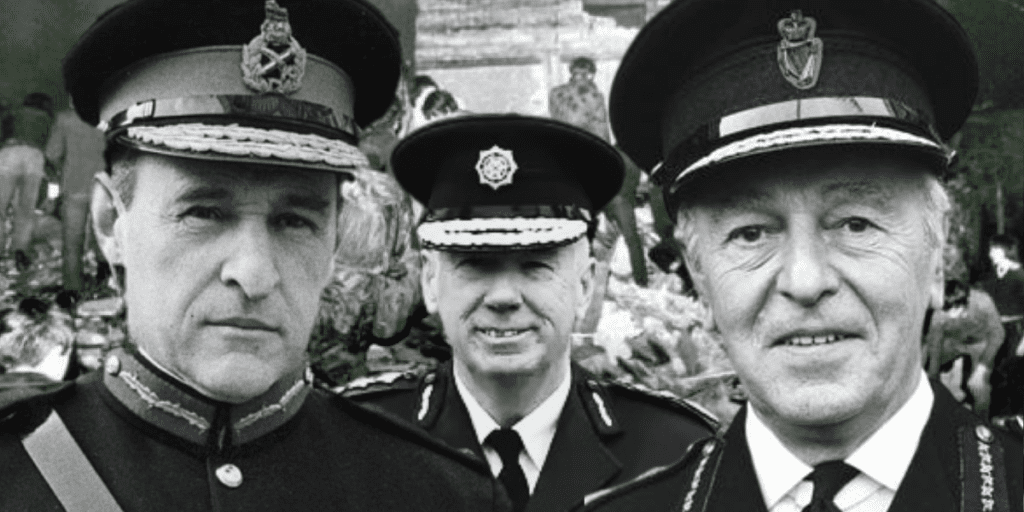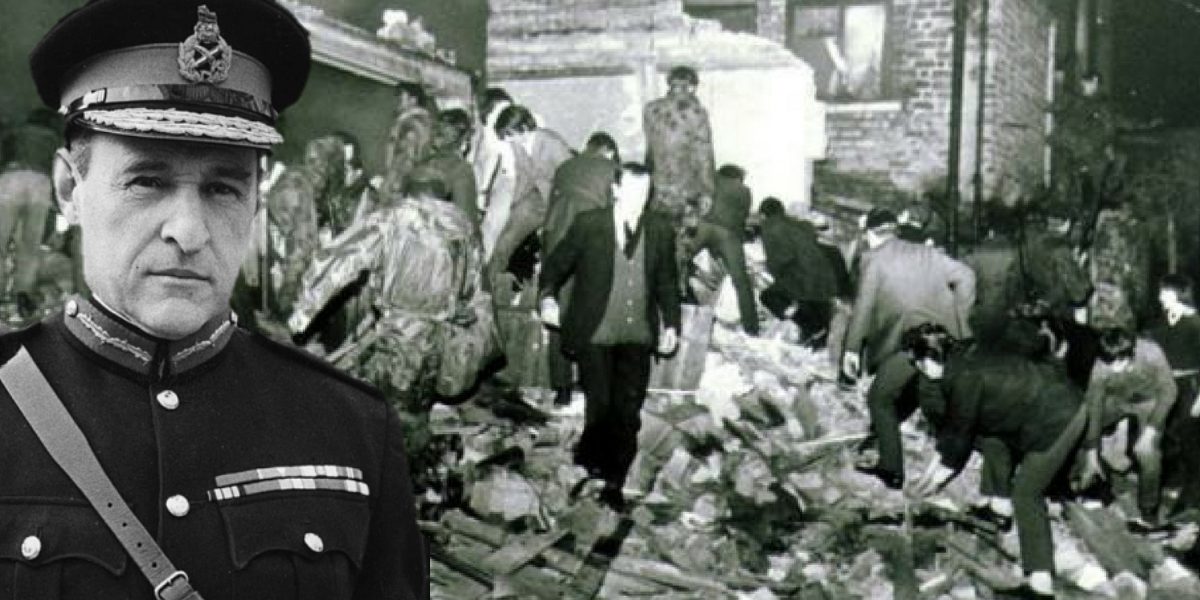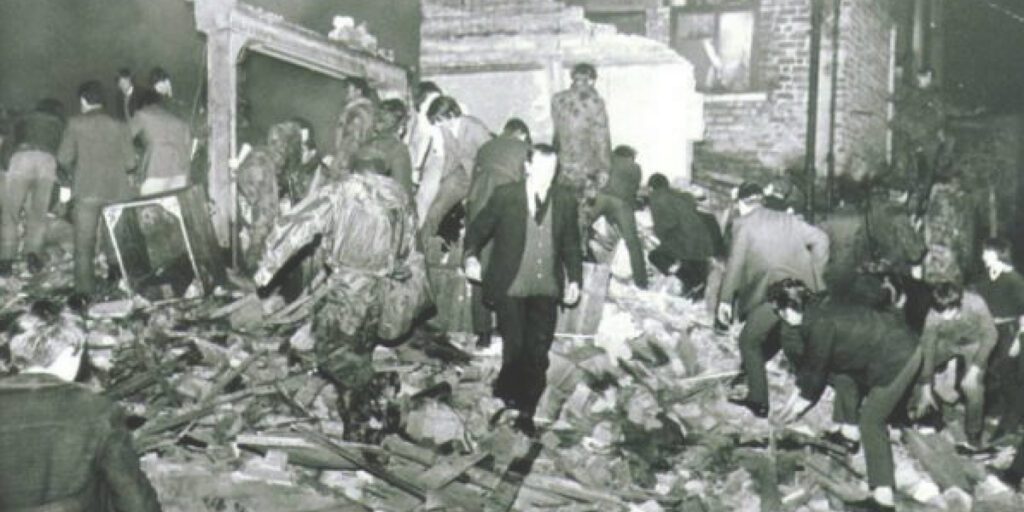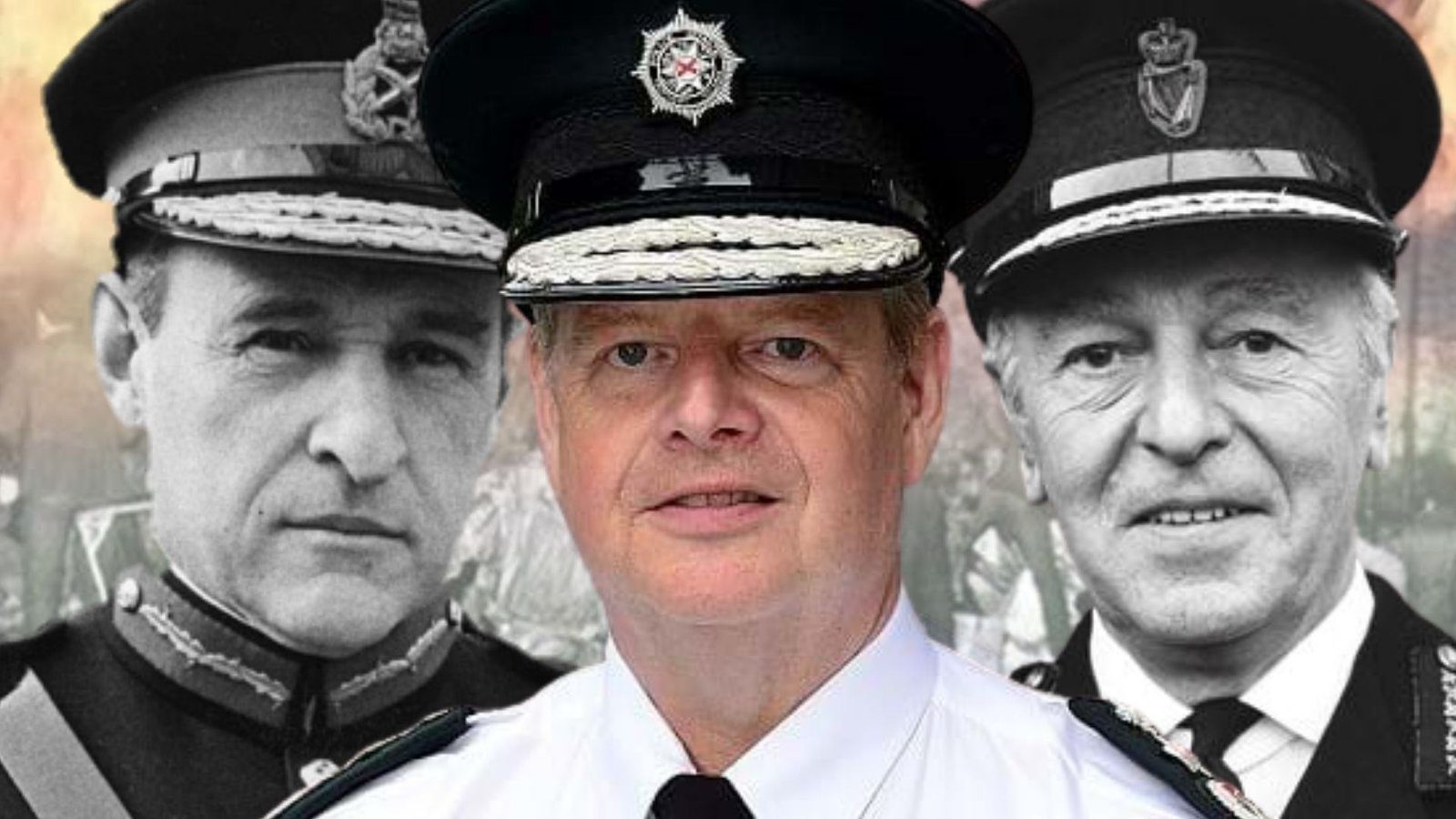Foreword by Colin Wallace
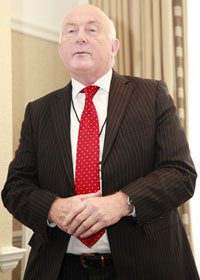
Colin Wallace (right), former Senior Information Officer at the heart of the British Army’s psychological operations unit in the early 1970s, has been helping me translate secret military archives which I discovered.
When I wrote my book, he was the first and only person I wished would write its foreword.
This is it:
At a quarter to nine on the Saturday evening of 4 December 1971, Loyalist extremists detonated a bomb in the doorway of a tiny pub at the junction of North Queen Street and Great George’s Street inBelfast. The explosion demolished what was known as McGurk’s Bar, killing 15 people and wounding a further 13. The youngest person to
die was a 13 year old schoolboy, James Francis Cromie, and the oldest was 73 year old Philip Garry, a school crossing patrolman.
In an outburst of rioting that followed the bombing, Major Jeremy Snow, from the Royal Regiment of Fusiliers, was shot and wounded by gunmen from the staunchly Republican New Lodge area. Major Snow died in hospital three days later.
Even taking into account the shameful nature of the violence that ravaged Ireland during the 1970s and 1980s, the bombing of McGurk’s Bar stands out as being particularly cowardly. The bombers simply dumped their lethal load at the pub when they were too frightened to attack their intended target.
Attacks such as those which occurred in Belfast on ‘Bloody Friday’ in 1972 and in Dublin and Monaghan in 1974 were, of course, equally despicable, but the McGurk’s attack was made much more intolerable for the relatives of the dead and injured because Government sources firmly laid the blame for the explosion on those who were in the pub that night. To make matters worse, they continued with that deception long after they were aware that the claim was totally untrue. Why?
Context for the BombingDuring the 1970s, I was the Senior Information Officer at Army Headquarters in Northern Ireland and therefore had a detailed working knowledge of security events throughout the Province on a day-to-day basis. 1972 was a significant year in the development of what is often referred to as ‘The Troubles’ and it is important to understand some of the key political and security events that led up to the bombing of McGurk’s Bar.
In February of that year, the first British soldier to be killed by the IRA, Gunner Robert Curtis, was shot in Belfast. The following month, the Provisional IRA ‘befriended’ three soldiers from the Royal Highland Fusiliers, brothers John and Joseph McCaig from Ayr and Dougald McCaughey from Glasgow. The soldiers were lured to an isolated area on the northern outskirts of Belfast where they were murdered by the Provisional Irish Republican Army (PIRA).
The murders provoked a sense of outrage throughout Britain and Ireland – partly because two of the soldiers were still in their teens and partly because two of them were brothers. The public revulsion over the killings was a contributing factor in the resignation of James Chichester-Clark as Northern Ireland Prime Minister ten days later.
Brian Faulkner became the new Prime Minister, but the security situation continued to deteriorate. On 8 July in separate incidents in Derry, the British Army shot two men dead: Seamus Cusack and Desmond Beattie. The Army maintained that both men had been armed but local witnesses said they were not. In the ensuing controversy, members of the moderate Social Democratic and Labour Party withdrew from the Stormont Parliament in protest.
As the security situation continued to deteriorate, hard-liners in the Unionist Party pressed Brian Faulkner to adopt much tougher measures, including the introduction of internment without trial. At the same time, Whitehall became increasingly frustrated and impatient with Stormont, but realised that Brian Faulkner was the last hope of maintaining the Northern Ireland Parliament. Although Brian Faulkner demanded that Whitehall introduce internment, he realised he would lose the support of his party if Loyalists were interned.
To complicate matters further, the Army General Officer Commanding (GOC), Lieutenant General Sir Harry Tuzo and the British Defence Secretary, Lord Carrington, were both strongly opposed to the introduction of internment. General Tuzo, a particularly intelligent and politically astute officer, realised that any short-term gains obtained from internment would be greatly outweighed in the long-term by polarisation and disaffection within the wider community.
In the event, Edward Heath decided to overrule the Army view and the internment operation went ahead as Brian Faulkner had requested.
The outcome was very much as General Tuzo had predicted.
Internment Without TrialThe Security Forces did gain some important Intelligence from the operation, but many of those arrested were either insignificant in terms of paramilitary activity, or wrongly identified. Much of the information about individuals came from the Royal Ulster Constabulary (RUC) Special Branch and was years out-of-date. Loyalist paramilitaries were initially excluded from internment in keeping with Brian Faulkner’s request and because Whitehall did not want the Security Forces to have to fight on two fronts at the same time.
The violence that followed the internment operation had a considerable impact on the security situation. The IRA increased its attacks and bombed a number of pubs and clubs in Loyalist areas. In September, Loyalist frustration with the situation increased and some 20,000 people attended a rally at Victoria Park, Belfast, to call for the establishment of a “third force to defend Ulster”. To meet the growing attacks from the IRA, a number of Loyalist Defence Associations came together and formed the Ulster Defence Association. This new organisation was in direct competition with the Ulster Volunteer Force and both groups set out to demonstrate that they were more capable than the Security Forces of dealing with the growing IRA violence.
Control of InformationThe British Government was acutely aware of the growing disquiet of the electorate about events in Northern Ireland – especially the deaths of British soldiers. Whitehall became increasingly irritated by press coverage of the Northern Ireland situation and the Defence Secretary criticised the BBC for its alleged political bias when reporting the violence.
The Army too was blamed for not taking a sufficiently aggressive stance on its management of the media and the Government decided to send a number of ‘information advisers’ to the Province to create an information strategy to counter what was regarded by Whitehall as terrorist propaganda successes.
It is my belief that the officially disseminated disinformation that surrounded the McGurk’s Bar bombing was a product of that information strategy.
That NightI was on duty at Army Headquarters on the night McGurk’s Bar was bombed and I still have a clear recollection of the aftermath, mainly because of the large number of casualties and the shooting of Major Jeremy Snow. There is no doubt in my mind that the original information we received from Security Forces’ personnel at the
scene indicated that the bomb had been planted outside the pub.
Furthermore, the Army Explosive Ordnance Disposal team that went to the site of the explosion were of the opinion that the bomb had detonated outside the bar. By the time I went off duty that night, all the ‘evidence’ indicated that the attack had been carried out by Loyalists.
I was therefore surprised to find out the following morning that the official line being taken was that the explosion had been what was commonly referred to as ‘an own goal’, that it was a bomb that had detonated prematurely while still in the possession of those who were using it. Although the official line on the incident had changed, I was not made aware of any new information that justified this change of view. Setting aside what information we had gained from those who were at the scene of the explosion, we knew that McGurk’s Bar was not regarded by the Security Forces as a place frequented by either wing of the IRA. What possible reason would the IRA have for bombing it? Why would the IRA wish to alienate its own supporters by carrying out such an attack?
Significantly, none of the victims had any known connection with the IRA and the vast majority were much older than those traditionally engaged in paramilitary activity.
The Art of WarAeschylus, the 5th century Greek dramatist, said: “In war, truth is the first casualty”. Deception operations and psychological warfare activities have a legitimate role to play in any armed conflict, but those activities must be carefully managed otherwise they can become counter-productive and undermine other security operations.
Whitehall’s information strategy in Northern Ireland in 1971 had a number of key themes. Overall, those themes were designed to increase support for the Security Forces and wean support away from the paramilitaries.
A key part of weaning support away from the terrorists was to convince the community not to store bombs or explosives for the extremists. Clearly, if bombs did explode prematurely, such incidents would help to convince those who might be tempted to store such material that it was a very risky activity. Also, when extremists were forced to move their explosives around or store them in unoccupied buildings, the chances of the materials being discovered increased considerably. It was also important to demonstrate that the extremists had no regard for the lives of those who lived in their community.
I have no direct knowledge as to why the official account of the bombing changed in the hours following the explosion – I can only offer my considered opinion. Indeed, in my experience, initial information emerging from an incident is often inaccurate but becomes accurate with the passage of time and discovery of detail. The
McGurk’s Bar incident is unusual in that the initial assessment by the British Army was accurate, but subsequent Intelligence reports were totally inaccurate. significantly, the inaccurate Intelligence reports matched the information being disseminated by official sources and that required quite a considerable degree of co-ordination at a high level. Brian Faulkner, for example, was at pains to tell Home Secretary, Reginald Maudling, that Intelligence reports indicated that the bomb that demolished McGurk’s Bar was an IRA one.
An initial verbal report by an Army Ammunition Technical Officer at the scene indicated that it was unlikely that the device had been placed against the outer wall of the building. He estimated that high explosive (not enclosed in a container such as a beer keg) had been used and probably initiated by a combustion fuse. However, because of the on-going attempted rescue operation that was in progress, he could not identify where the seat of the explosion was. Although he did not know it at that time, his opinion was consistent with an eyewitness account that the bomb had been placed in the Great George’s Street lobby of the pub. The ATO’s view was only a very cursory assessment, but a subsequent forensic report by a scientist working on behalf of the RUC largely corroborated his opinion.
Significantly, a report submitted to The Director of Operations, Lt General Sir Harry Tuzo, the following morning stated that the bomb was believed to have been planted outside the pub. In other words, some twelve hours after the bombing, there was still no suggestion by the Security Forces that the bomb had detonated in the bar where the victims were located at the time of the explosion.
Information PolicyClearly, the bombing of McGurk’s Bar created a major public relations problem for Whitehall. The bombing resulted in the largest single loss of life during ‘The Troubles’ and, if the attack had been attributed to the UVF, serious questions would have been raised over
why Loyalist paramilitaries were not being interned. On the other hand, if the bombing could be shown that the IRA was directly or indirectly responsible then this would be seen as further justification for Internment.
The McGurk’s Bar bombing was one of the worst acts of mass murder in the history of the State. It was a shameful crime and its handling by the authorities was also shameful. To seek closure to this dreadful matter is not about being pro-Republican or anti-Loyalist; nor is it about being against the Security Forces. It is simply a matter of fairness and justice.
This book is a tribute to one man’s remarkable, single-handed fight for justice: justice, not for himself, but for the innocent people who were murdered by Loyalist extremists in a tiny pub in Belfast. Ciarán MacAirt’s relentless search for the truth has unearthed a trail of official documents which demonstrates how the State authorities cynically and deliberately not only allowed the victims and their families to bear the blame for the outrage, but also used the event to their own political and security advantage. It is a powerful indictment of an abuse of power by the State – an abuse that should be addressed without further delay.
Colin Wallace, August 2012
The McGurk’s Bar Bombing
Collusion, Cover-Up and a Campaign for TruthBy Ciarán MacAirt
 Available at Easons | Waterstones | Amazon
Available at Easons | Waterstones | Amazon

